Speech Recent Debt Market Developments

Guy Debelle[1]
Assistant Governor (Financial Markets)
Address to the Debt Markets 2008 Summit
Sydney –
Today, I'm going to summarise some of the developments in the Australian bond market over the year since the credit turmoil began. After giving a general overview, I will focus on two topical issues in the Australian debt markets: the roles of lenders' mortgage insurance and the monoline insurers.
It is useful to split the Australian bond market into six major categories shown in Table 1.
| Outstanding ($ billion) |
Share (per cent) |
Annual growth (per cent) |
|||
|---|---|---|---|---|---|
| June 2007 | June 2008 | June 2008 | 2007–2008 | 2003–2008 | |
| CGS | 53.2 | 55.4 | 5.5 | 4.1 | −0.5 |
| Semis | 90.4 | 101.0 | 10.0 | 11.7 | 9.8 |
| Financials | 303.1 | 362.0 | 36.0 | 19.4 | 19.7 |
| Corporate | 134.8 | 135.0 | 13.4 | 0.2 | 10.1 |
| Asset-backed bonds | 222.4 | 181.3 | 18.0 | −18.5 | 14.0 |
| Non-residents | 172.7 | 171.1 | 17.0 | −0.9 | 21.0 |
| Total | 976.7 | 1005.9 | 100.0 | 3.0 | 14.5 |
|
*Bonds issued by Australian entities onshore and offshore, and bonds issued by non-residents in Australia and in A$ offshore. Sources: ABS; RBA |
|||||
1. Public Sector
The stock of Commonwealth Government securities (CGS) and bonds issued by state government borrowing authorities (semis) has been relatively stable for a number of years. For CGS, this has reflected the Australian Government's commitment to maintain a stock of CGS of around $50 billion, notwithstanding ongoing budget surpluses. In May 2008, the Australian Government announced that it will increase future CGS issuance by up to $25 billion in order to maintain liquidity in both the spot and futures CGS markets. Issuance in the 2008/09 financial year is to increase by $5 billion.
The state governments have also, on average, tended to run budget surpluses, though the stock of semis outstanding increased by 12 per cent last year as the states raised funds for a number of infrastructure projects. Nearly a third of semis outstanding have been issued offshore. Foreign investors have tended to prefer to buy semis issued offshore as, unlike semis issued onshore, they were not subject to Interest Withholding Tax (IWT). In the latest budget, the Australian Government announced that domestically issued semis would be eligible for exemption from IWT. This measure is expected to consolidate future semi-government issuance into the domestic market which will improve the depth and liquidity of the market.
Following the onset of the recent credit turmoil and the general reappraisal of risk by market participants, spreads on all bonds relative to CGS have increased. Despite their high credit quality, semis were no exception to this (Graph 1). For example, the 10‑year spread between semis and CGS has averaged 55 basis points over the past year, around double the margin typical before mid 2007. This increase is hard to explain because the credit risk of semi-government bonds is very low and is unlikely to have increased over this period. One possible explanation is that investors, particularly offshore, have preferred to only hold the sovereign name in times of diminished risk appetite. Another is that there has been a liquidity premium in the CGS market.
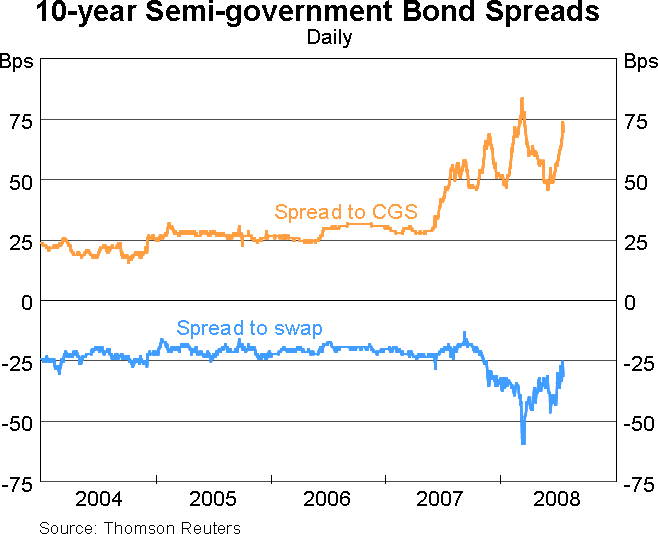
2. Financials
The stock of non-government bonds has increased markedly over the past year, with much of this growth being driven by the financial sector. Australian banks' bond issuance has been very strong, particularly in the first half of 2008, when issuance totalled $67 billion, well above the average $32 billion raised in the same period in 2005–2007 (Graph 2).
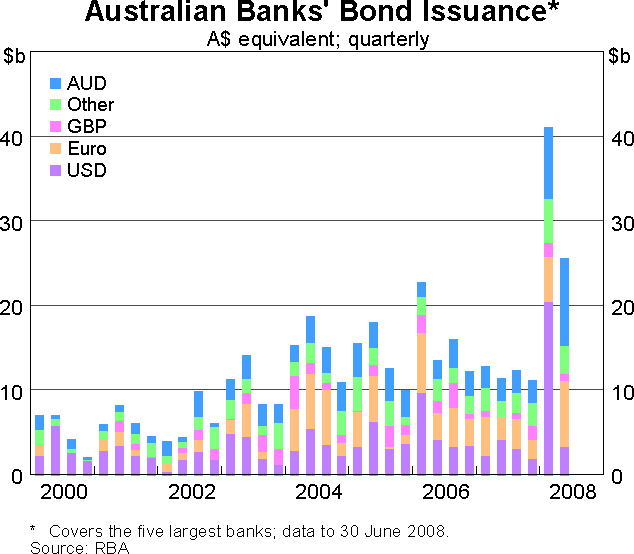
The strong bond issuance reflects the re-intermediation that has taken place during the credit market turmoil, with banks undertaking a larger share of financing for the non-government sector. This is evident in the fact that, notwithstanding the strong financial issuance, total non-government bond issuance has been around average levels over the first half of the year (Graph 3).
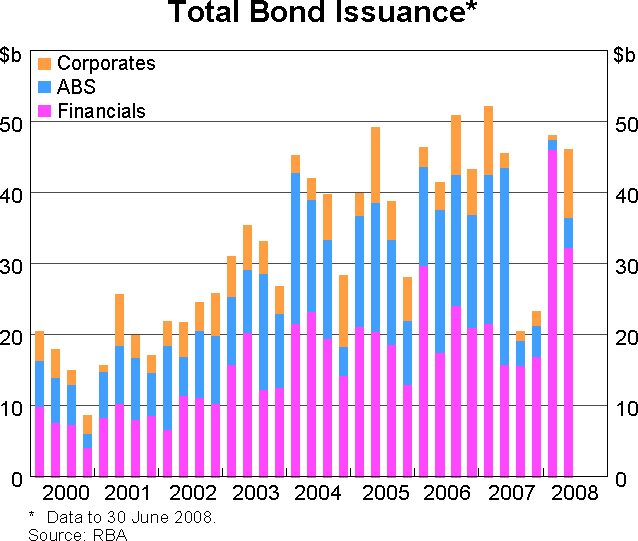
In part, the issuance by the banks has also been precautionary in case the dislocation in credit markets was to worsen. The major banks are generally ahead on their funding plans: the issuance has been more than enough to meet the banks' asset growth and maturation of existing issues.
Over two-thirds of the banks' bond issuance has been offshore and denominated in foreign currencies, particularly US dollars and euros. The choice of funding location primarily reflects cost considerations and the ability to tap long-standing buyer relationships. Earlier in the year, there were concerns that investors would have difficulty ‘digesting’ further offshore issuance, but this has not been borne out. Investor demand for bank paper (onshore and offshore) has been strong, with most recent issues oversubscribed.
Banks have been tapping new sources of funds and diversifying their issuance across different markets. A significant share of bond issuance in the March quarter was in the form of extendible bonds in the US through private placements. Each of the major banks has also recently tapped the Japanese market by issuing so-called ‘Samurai’ bonds for the first time. This enabled the banks to issue bonds at longer tenors (typically five years) than those issued in the US in early 2008.
Reflecting the pattern of issuance of shorter-tenor bonds earlier in the year, the average term to maturity of newly issued bank bonds narrowed to around two years in the March quarter, down from 4½ years prior to the strains in markets (Graph 4). However, the major banks have lengthened the maturity of their bond issuance more recently. As a result, the average maturity of total outstanding bonds has only declined a little.
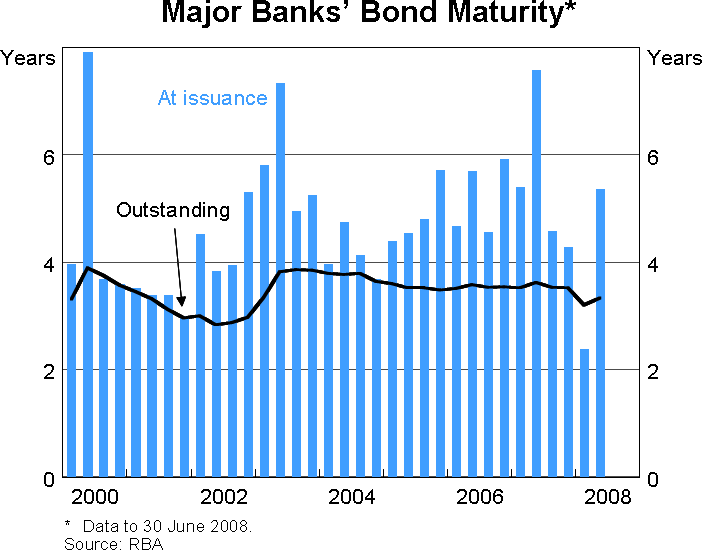
As has been the case globally, the costs of raising funds in term markets for Australian banks have been at high levels throughout the credit market turmoil. There had been some signs that spreads eased over the June quarter from their April peaks. For example, banks issued five-year bonds at a spread of a little over 100 basis points above the bank bill swap rate (BBSW) in June, compared to 128 basis points in April, though they were able to issue comparable bonds at spreads of less than 20 basis points a year ago (Graph 5).
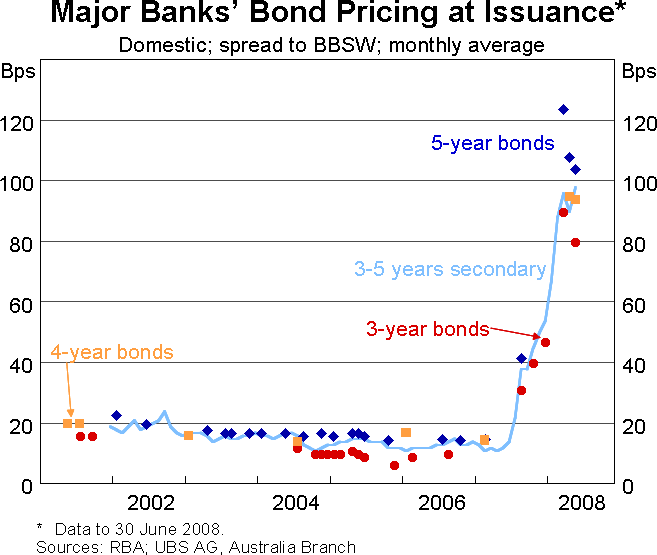
3. Securitisation
While the repricing of risk has affected all areas of the Australian bond market, the securitisation market has been the most affected. Since the onset of the credit market strains in mid 2007, the volume of Australian residential mortgage-backed securities (RMBS) issuance has been very low; quarterly issuance has averaged $2 billion compared to average quarterly issuance of $18 billion over the previous year (Graph 6). Reflecting the low level of issuance together with the amortisation of the existing issues, the stock of RMBS outstanding has fallen by around 20 per cent since the peak in mid 2007 to $140 billion (Graph 7). The fall has been more pronounced offshore, as the limited issuance that has taken place has been onshore.
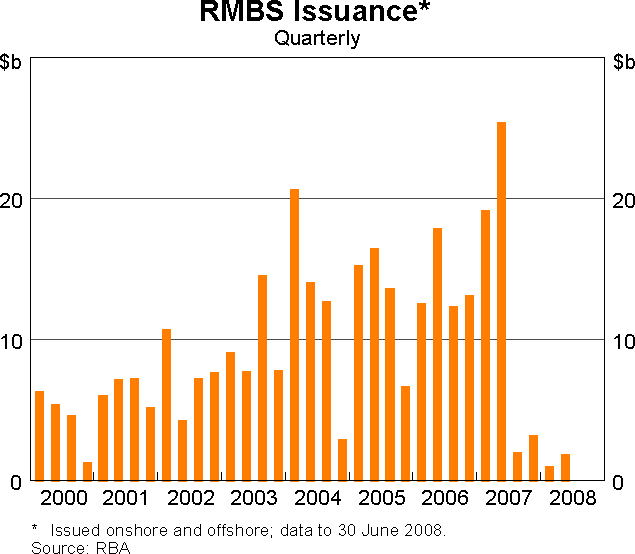
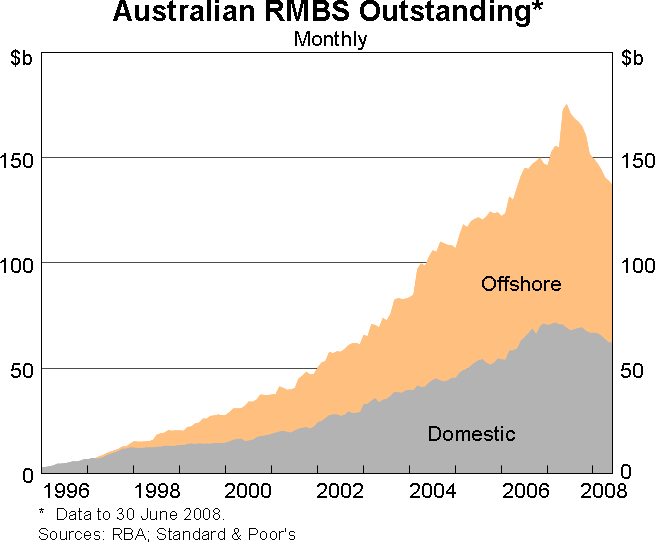
Although the securitisation market continues to be dislocated, there have recently been some signs of improvement, with a number of public issues taking place in recent weeks. Some of these issues have been upsized or oversubscribed due to strong investor demand. A few securitisations of auto loans have also taken place.
The RMBS that have been issued during the current period of volatility have been much smaller than was previously typical ($375 million compared to $1.6 billion). Investors have also been differentiating on pricing across the characteristics of the underlying loans such as low-doc or non-conforming for equivalently rated tranches. More recently, there has been a trend towards new prime RMBS being structured so that the rating of the senior tranche is independent of the credit enhancement provided by lenders' mortgage insurance (LMI), following concerns about the mortgage insurance and bond insurance sector, which I'll come back to shortly. Both prime and non-conforming senior tranches have been structured with more subordination than required to obtain a AAA rating.
It may be useful to give a simple stylised example to demonstrate how the elevated spreads affect the economics of RMBS issuance (Table 2). In a typical RMBS, a special purpose vehicle (SPV) receives income from the mortgage payments it receives; in this example here, I've used an estimate of the average mortgage rate on new loans, of 9 per cent. The mortgage income is used to cover the SPV's funding costs (bank bill rate plus a spread) and other costs such as loan servicing (here assumed to be around 50 basis points per annum). The higher the spread that the SPV needs to pay, the more likely it is that there will be a shortfall between the income it receives and the required payments. In the example below, at a spread of 150 basis points, an RMBS is not viable, whereas issuing an RMBS at a spread of around 20 basis points, similar to the margin prior to the turmoil in markets, would have been profitable. In the example here, the break-even spread is around 100 basis points, which is in the ball park suggested by market liaison, although different lenders are likely to have different cost structures. Moreover, the weighted average interest rate on a mortgage pool varies quite a lot with the characteristics of the loans in the pool, with a low-doc loan having a higher lending rate and hence being economic at a higher spread.
| Spread of 150 bps | Spread of 20 bps | |
|---|---|---|
| Weighted average mortgage interest rate | 9.00 | 9.00 |
| Costs | ||
| Bank bill rate | 7.60 | 7.60 |
| Spread | 1.50 | 0.20 |
| Loan administration/transaction costs | 0.50 | 0.50 |
| Total costs | 9.60 | 8.30 |
|
Source: RBA |
||
With the recent issuance in the primary market, there are some signs that spreads have narrowed, with prime full-doc AAA-rated RMBS pricing at spreads of around 120 basis points in June, down from 145 basis points in May (Graph 8). Reflecting the higher premium required by investors for low-doc loans, a low-doc AAA-tranche priced at a spread of 180 basis points in June.
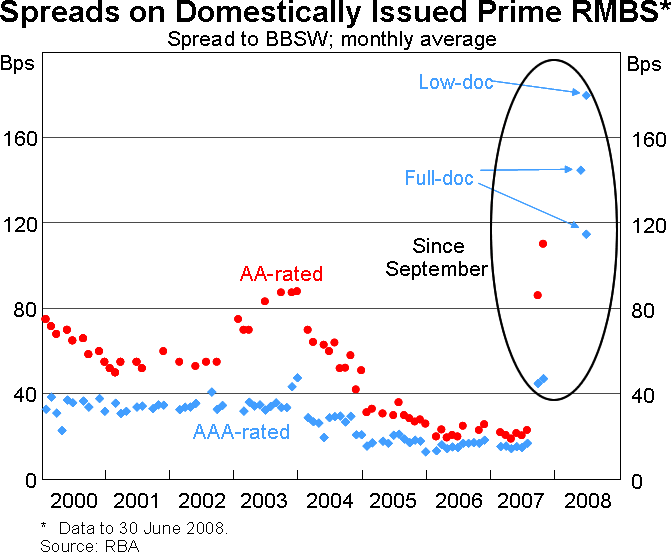
The currently elevated spreads appear to reflect mark-to-market concerns on the part of investors, rather than concerns about losses on RMBS. Investors in rated Australian RMBS have never suffered any losses of principal – any losses on the underlying loans after the sale of the property have been covered by LMI, the profits of the securitisation vehicles, and to a lesser extent, unrated tranches. Although losses on loans increased in 2007, they are still relatively low as a share of outstandings (4 basis points for prime loans).
Conditions have also been very strained in the asset-backed commercial paper (ABCP) market since mid 2007, with Australian ABCP outstanding falling 30 per cent since the peak in July 2007. Reflecting the more dislocated conditions in the US, Australian-domiciled conduits have switched a large share of ABCP onshore. The slightly better performance of the Australian market owes, in part, to the different purpose of ABCP conduits in Australia, which are used to fund loans rather than securities to a greater extent than in the United States.[2] Spreads continue to be at elevated levels – around 50 to 60 basis points spread to the bank bill swap rate compared to an average spread of 5 basis points prior to the onset of the turbulence.
4. Corporates
Since the onset of the credit crisis, corporate bond issuance has been limited, with businesses largely turning to the banking sector for funds. However, in the June quarter, corporate bond issuance was $10 billion, similar to issuance prior to mid 2007. All of these bonds were issued offshore in US dollars by large well-known companies that find it easier to tap wholesale funding. Around half of the value of bonds issued in the June quarter was due to Rio Tinto partly refinancing debt related to the acquisition of Alcan.
5. Kangaroos
Activity in the Kangaroo market increased significantly in the first half of 2008 relative to the last half of 2007, but remained somewhat subdued compared to before the strains in markets (Graph 9). Only issuers with very high credit quality have accessed the market in 2008; all bonds were issued by AAA-rated entities and most issues were by supranationals or sovereigns. Kangaroo issuance accounted for one quarter of issuance in the domestic market over this period.
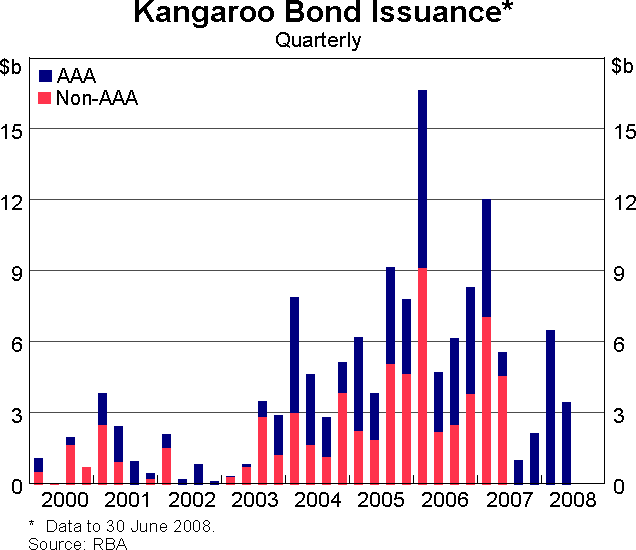
Around three-quarters of issuance has been through taps of existing lines. Reflecting this, the average issuance tenor has been shorter than usual, although it has increased somewhat relative to the second half of 2007. The average issuance size also increased to be close to the typical deal size before July 2007.
6. Lenders' Mortgage Insurance (LMI)
Almost all prime RMBS issued in the Australian market are covered by LMI – this is a major part of the credit enhancement of these products. In contrast, non-conforming RMBS, which only make up around 5 per cent of Australian RMBS, generally do not have LMI; subordination is the main form of credit enhancement.
The two main participants in the Australian LMI market are Genworth and PMI, with respective prime RMBS market shares of around 55 and 40 per cent. In recent months, the rating agencies have downgraded PMI to AA- from AA, with Moody's having also downgraded Genworth equivalently. These moves followed downgrades to the parent companies after they suffered losses this year in the US housing market. In the case of PMI, the rating agencies acknowledged the relative strength of the local operations and regulatory framework, and confirmed that PMI Australia has been successfully ‘quarantined’ so as to maintain a higher rating than its US-based parent.[3]
The downgrades of the two mortgage insurers have resulted in around 190 subordinated RMBS tranches being downgraded to AA- from AA. However, the ratings of all senior tranches (AAA) were affirmed as they were deemed to have sufficient protection from subordination to withstand a one notch downgrade of the LMI provider. Since subordinated tranches only make up a small share of the value of an RMBS, the overall effect of these downgrades on the RMBS market has been small, with less than 5 per cent by value of outstanding RMBS affected.
Recent analysis by S&P concluded that the AAA rating of outstanding senior tranches is largely resilient to LMI downgrades. Even if the mortgage insurers were downgraded to BBB or below (at which point S&P gives no credit to the LMI provider), 59 per cent of the AAA-rated tranches by number (39 per cent by value) would retain their AAA rating. Moreover, almost all senior tranches would retain a rating of A- or higher; with only one tranche rated below investment grade. The relative immunity to LMI downgrades is mainly due to mortgage repayments increasing the subordination levels over time, and the increasing tendency of issuers to provide a level of subordination higher than that required to gain a AAA rating.
As I mentioned earlier, of the RMBS issued so far this year, almost all AAA-rated tranches have been LMI independent. On average, they had nearly one and a half times the amount of subordination required to be considered immune from LMI downgrades.
7. Credit-wrapped Bonds
So far in 2008, there have been widespread rating downgrades of US financial guaranty insurers, also known as monolines. Monolines insure, or ‘credit wrap’ bonds.[4] This is a type of credit enhancement whereby a bond insurer guarantees to meet interest and principal payments if the issuer cannot. The rating of a credit-wrapped bond is generally set at the higher of the insurer's or issuer's rating.
The main reasons cited for the downgrades were the worsening expected losses for US sub-prime related securities, and the effect these losses – combined with the low expected business growth – would have on the monolines' capital. All of the monolines are currently either on review for further downgrades or have a medium-term outlook that suggests further downgrades may occur.
The problems in the monolines in the US have affected the Australian market, where credit wrapping is primarily used by domestic investment-grade corporates (typically airports, utilities and infrastructure related issuers), which are mostly rated BBB. The credit wrapping has allowed the issuers to obtain a higher rating for the bond and enabled them to issue at longer maturities and lower spreads than otherwise.
There are currently around $27 billion of credit-wrapped bonds outstanding in Australia, accounting for 7 per cent of the domestic non-government market (Graph 10). The two largest US monolines operating in the Australian market are MBIA and Ambac, which account for around 60 per cent of the market. The monoline downgrades have flowed through to the credit-wrapped bonds, with around 80 per cent of the domestic credit-wrapped bond market having been downgraded below AAA. Thus far, nearly all the bonds have been downgraded to the same rating as the monoline insurer (mostly AA by S&P and A2 by Moody's).
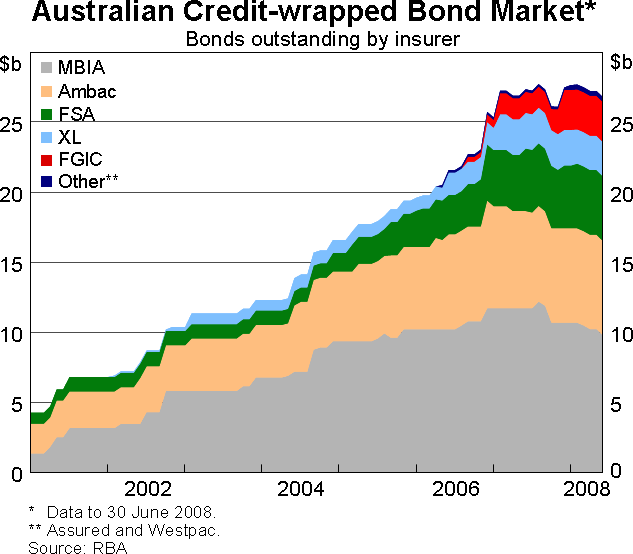
Partly in anticipation of the monoline downgrades, the margin between credit-wrapped bonds and other non-government unsecured AAA-rated bonds in the secondary market has increased from an average of 25 basis points in July 2007 to around 130 basis points (Graph 11). While the spreads on credit-wrapped bonds have increased, they remain significantly below spreads on bonds with similar ratings to the underlying issuers.
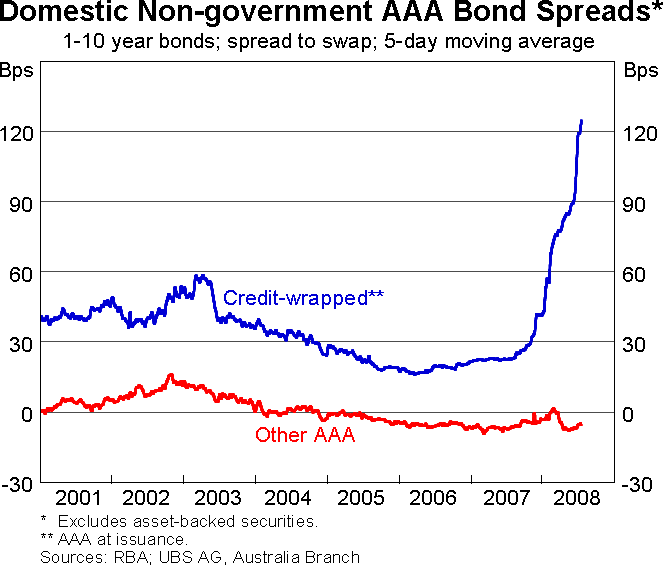
Around half of credit-wrapped bond investors (banks, insurers, ABCP conduits and structured investment vehicles) have mandates to hold only highly rated bonds and may be required to sell, or have already sold, the bonds that have been downgraded below the AA rating category. Most of the other investors are fund managers who can only hold investment-grade bonds. As the actual issuers of the bonds are generally at least investment grade, this would be likely to put a floor under the rating of these bonds, even if the ratings of the monoline insurers were downgraded below that.
8. Conclusion
It has been a turbulent time in global credit markets over the past year. While there have been areas of dislocation in the Australian credit market, there have also been areas of strength. The process of re-intermediation has seen strong issuance by financials, particularly the major banks. This has substituted for the dislocation in asset-backed and corporate bond markets.
The rating downgrades of mortgage insurers and monoline bond insurers have had an effect on parts of the local bond market. However, that exposure has been confined to a few relatively small pockets. Those parts of the market which have been directly affected have proven to be relatively resilient to these downgrades. In the case of the mortgage insurers, in part this has reflected the strength of the underlying asset class which has reduced the importance of mortgage insurance in the value of the security.
Endnotes
I thank Ivailo Arsov, Sue Black, Anthony Brassil and John MacDonald-Hill for their help. [1]
See Black S and C Fisher (2008), ‘The Asset-Backed Commercial Paper Market’, RBA Bulletin, January, pp 1–10. [2]
PMI Australia (PMI Mortgage Insurance Ltd) is rated one notch above its US-based parent (PMI Mortgage Insurance Co.) by S&P and Fitch, and three notches above by Moody's. [3]
See Box A of the RBA's March 2008 Financial Stability Review, pp 16–17. [4]